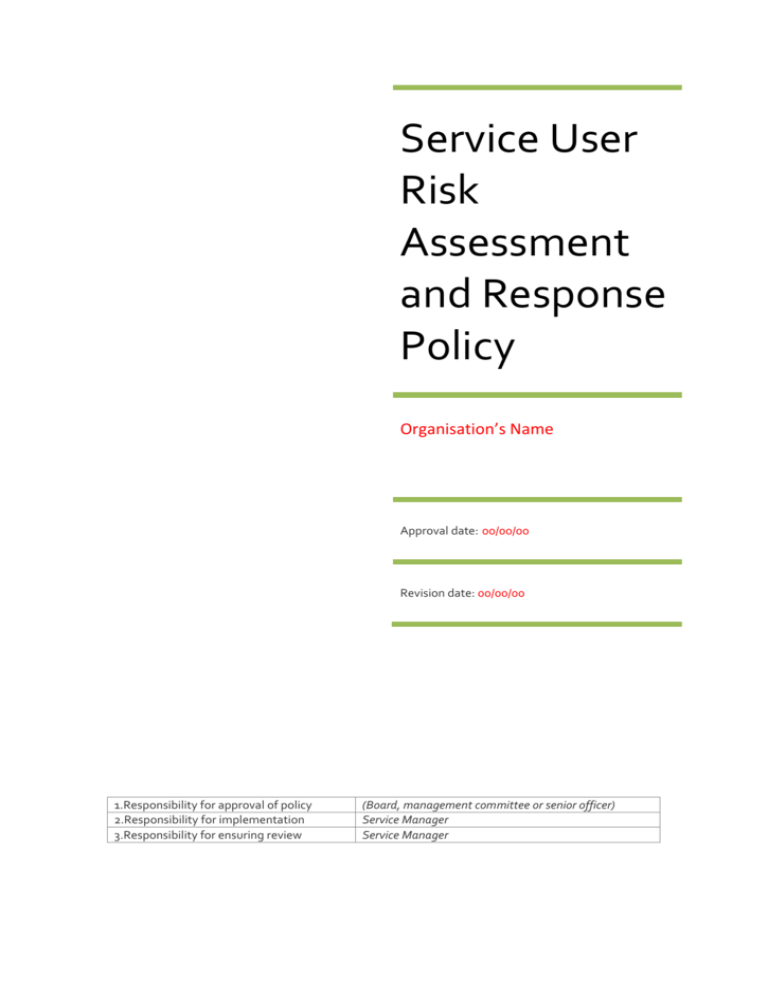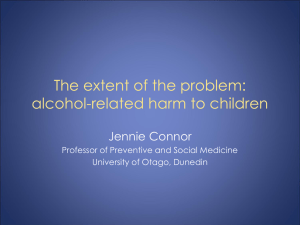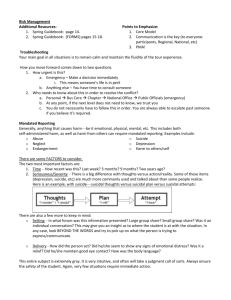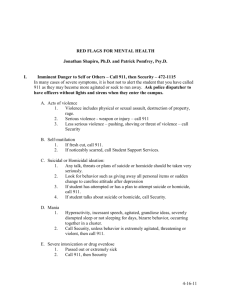Service User Risk Assessment and Response Policy
advertisement

Service User Risk Assessment and Response Policy Organisation’s Name Approval date: 00/00/00 Revision date: 00/00/00 1.Responsibility for approval of policy 2.Responsibility for implementation 3.Responsibility for ensuring review (Board, management committee or senior officer) Service Manager Service Manager Name of Organisation Risk Assessment and Response Policy 1. Policy Statement ______________ (name of organisation) recognises it’s responsibilities to provide a safe environment to service users, staff and other stakeholders attending the service. Children first guidelines will be consulted in relation to all individuals under eighteen years of age. 2. Purpose This policy outlines the rationale and process for service users risk assessment, review and response. 3. Scope This policy applies to all employees of ______________ (name of organisation), across all areas of service provision. 4. Glossary of Terms and Definitions 4.1. Risk assessment: the tool (appendixed) and process used to identify and quantify level of risk in relation to the following categories; 4.1.1. Self harm 4.1.2. Suicide 4.1.3. Risk of overdose 4.1.4. Threat of violence to others by the individual 4.1.5. Threat of violence to the individual by others 4.2. Children First Guidelines: national guidelines for protecting individuals under 18 from abuse (physical, emotional and sexual) or neglect (see the service’s Child Protection Policy). 5. Principles 5.1. ______________ (name of organisation) is committed to providing a safe and secure environment for all staff, service users and other stakeholders. 5.2. The management of risk is an important aspect of the service we deliver, in doing this we aim to ensure that potential risk does not limit a person’s access to or ability to engage with a service. 5.3. ______________ (name of organisation) shall actively assess the types and levels of risk, with the aim of negating or mitigating these risks as far as is practicable. 5.4. Risk assessment is an integral part of assessment and key working processes. 5.5. Risk assessments shall be carried out both formally and also informally as an ongoing process over time. Formal risk assessments shall be carried out in a non-judgemental manner where the service user is empowered to be part of their own risk management. 5.6. In relation to informal risk assessment, staff should always remain conscious of the risks inherent in their work practice and seek to identify possible risks in advance of incidents occurring. 5.7. When undertaken skilfully a risk assessment can support positive service user/staff relations. 6. Roles and Responsibilities 6.1. Management will be responsible for the mitigation of any identified risks to the greatest extent possible and practicable. 6.2. Management shall ensure that all staff, locum workers and volunteers have read and understand the contents of this policy 6.3. All staff, locum workers and volunteers are responsible for reporting perceived risks and for working in line with this policy. 7. Initial Risk Assessment with Service Users 7.1. All service users will have a risk assessment completed as part of the initial assessment, which will occur within the ……… (state time frame). 7.2. A second follow up risk assessment will be undertaken with services within……………., this will allow for a development of a trusting relationship between service user and staff member and may contribute to more honest answers. 7.3. Risk assessments will be conducted as part of a confidential, one-to-one session with a staff member / key worker. Name of Organisation Risk Assessment and Response Policy 7.4. The risk assessment shall cover both risks to self and risks to others (sample risk assessment form appendixed). 7.5. The service user will receive the following information in an empathetic and appropriate manner: 7.5.1. The purpose of the risk assessment is to ensure the service user’s safety as well as the safety of staff and other service users in the project. 7.5.2. The information in the risk assessment is confidential and will not be shared with anyone outside of the staff team, except in the instance of intent to harm self or others, or if the individual has been abused or intends to abuse/harm a child, or intends to commit a crime (see service Confidentiality Policy for more information). 7.5.3. Violence and weapons on the premises are not permitted and any breach of this rule is treated seriously. 7.6. The risk assessment will be filled out in as collaborative a manner as possible by both staff and service user, and will be signed by each to confirm that all steps have been followed and that the information has been understood. This provides an opportunity for the service user to take ownership of the assessment. 7.7. Where risks are apparent: 7.7.1. They will be discussed with the staff member’s line manager at the earliest convenience following the end of the session. 7.7.2. If during the session the staff member is unclear how to manage the risks identified, the service user should be informed that another meeting will be useful to discuss the issue and that the manager may attend to assist in exploring useful strategies to avoid risks / harms. 7.7.3. Strategies for managing risks should be agreed between the service user and key worker / manager and incorporated into the service user’s care plan. 7.7.4. The risk Matrix will be used as considered useful by the staff member / in all cases where risks are identified. 7.7.5. The contents of the risk assessment will be discussed with the full team in all cases / as required / at the discretion of the line manager / when medium or high risks are identified. 8. New Risks Identified through Key Working 8.1. Where staff assess that there are new risks or previously unidentified risks in relation to a service user then an additional risk assessment will be undertaken in response to this new information. 8.2. Triggers for risk assessment include, although are not restricted to: 8.2.1. Disclosure by the service user, or other service users, to any staff member of a risk situation. 8.2.2. Observed or reported risk of: suicide, self harm, harm to others or external harms to the individual. Identification of risk may be based on staff observation and/or other available information. Any information that triggers risk assessment should be discussed with the service user. 8.2.3. Service user behaviour, which includes, although is not restricted to aggressive behaviour and bringing weapons onto the premises. 8.3. If the service user is not in attendance at the time the risk is identified, and all efforts have been made by the service to contact the service user, then the risk assessment will be completed without the individual being present and discussed at the staff meeting. A full team decision will be made based on available information. As soon as the service user is in attendance the standard process will be implemented. 9. Risk Assessment – Team Decision Making 9.1. When a manager deems it necessary for an individual’s risk assessment to be discussed with the full team, the risk assessment and care plan will be presented to the full staff meeting with two possible outcomes: 9.1.1. The risk assessment has been completed and the service user and staff were able to agree on a care plan where the service can continue to support the individual who has agreed to undertake specific tasks / actions. 9.1.2. The risk assessment has been completed and the service user does not maintain that there are any risks, or a care plan agreement can not been reached. In this scenario the team will Name of Organisation 9.2. 9.3. 9.4. 9.5. Risk Assessment and Response Policy discuss the information provided in the risk assessment and will agree next steps. See below for issue specific guidelines: 9.1.2.1. Violence and aggressive behaviour or threat of external violence 9.1.2.1.1. If there is insufficient information or the risk is deemed as low risk; the situation will continue to be monitored. 9.1.2.1.2. If the situation is considered to be medium or high risk then actions will need to be agreed in order for the service to continue its support role. These will then be presented to the service user, if they are not in a position to agree these or suggest other actions that would be acceptable to the service then the service user will be asked to leave aspects of the programme / service. Interventions can include (although are not restricted to): time out, interagency meeting, respite, change of behaviour, contact with Garda or other support services, change of schedule, meeting with parents / guardians, accompaniment to external meetings, referral to another service (may include counselling services), 1-2-1 sessions, attendance at anger management course. 9.1.2.2. Suicide 9.1.2.2.1. In this case the services Suicide Intervention Policy should be followed. 9.1.2.3. Overdose 9.1.2.3.1. If this is considered intentional the Suicide Intervention Policy should also be followed. 9.1.2.3.2. If the overdose is in the last twelve hours the individual should be encouraged to see a doctor. 9.1.2.3.3. Staff should conduct a comprehensive harm reduction session, or refer to an agency with expertise in this area. 9.1.2.3.4. If the service user is being prescribed any medication such as benzodiazepines methadone or any other drugs, the prescribing doctor should be contacted and a three way meeting established to discuss overdose harm reduction strategy. 9.1.2.4. Risky drug use behaviour 9.1.2.4.1. Staff will provide comprehensive harm reduction session. or Staff will refer to service offering harm reduction sessions and support the individual to attend. This should be done in line with the organisations harm reduction policy. If the team cannot arrive at an agreed decision, a course of action will be determined by the manager. All staff will be obliged to follow and support this decision. Any issues should be dealt with through the grievance procedure. All decisions, following the staff meeting, will be communicated to the service user by two staff members, one to be a manager, as soon as possible. (for high threshold services) A service user will only be asked to leave a part or the entire programme if all reasonable efforts have been made to engage the individual in a risk management strategy and care planning, and that this has failed. If a service user is asked to leave the programme due to nonco-operation with the care plan then an exit plan will be made, which will also include a re-entry plan. The need for onward referral to other appropriate services will also be reviewed and undertaken as required. This should be done in line with the Inclusion Policy. In certain circumstances it will not be appropriate for the decision to be made at staff team level. Where this is the case, management shall assess the level of risk based on the process outlined above and taking cognisance of the likelihood and potential severity of the risk. Management shall inform staff and if necessary, service users of the outcome of the risk assessment and the way in which the risk shall be managed. 10. Risk Management in Relation to Under 18s 10.1. If the service user is under 18 and the risk assessment is considered serious then contact should be made with appropriate services as described within Children First Guidelines. The Child Protection Officer / manager within the service should be consulted in relation to this. 10.2. It should be noted that staff are under a legal obligation to report any crimes committed or planned to be committed that pose a viable and realistic threat of violence. Service users should be informed of this on entry to the project and prior to a disclosure. Name of Organisation Risk Assessment and Response Policy 10.3. Parents/Guardians will generally need to be contacted for services users under eighteen as described in Children First. Discretion can be used where a service user between the ages of 16 and 18 and is not in support of their parents being contacted, refer to the U18 Service Provision Policy for more detailed information. 11. Informal Risk Assessment 11.1. Risk assessment and management is an intrinsic element of the daily working processes of all staff. Staff shall remain conscious of all potential risks posed to or by service users and where they are concerned that a risk exists shall bring this to the attention of their line manager at the earliest convenience, the need for a new formal written risk assessment will be reviewed at this point. 11.2. In cases where this relates to information of criminal activity, the procedures outlined in the confidentiality policy shall be followed. 12. Risk Assessment Sharing with Other Services 12.1. If a service user has had risks identified through the assessment process and is attending another service through a referral from _____________ (name of organisation), then the key worker should request from the service user that the contents of the risk assessment be shared with the other service and written consent obtained 12.2. If service users are being referred to _____________ (name of organisation) from another service, it would be suitable to ask whether there are any issues arising in their own risk assessment process. Name of Organisation Appendix 1 Risk Assessment and Response Policy Initial Risk Assessment Form This form is completed with all service users as part of induction / on entry to the project / other. (Note it may be ideal to complete risk assessments on initial assessment / induction and then to repeat after a specified time period such as six weeks when a more trusting relationship has been formed).This form may also be used as new risks are identified or previously unidentified risks come to light. The staff member should make the service user aware of the following: This risk assessment is about protecting you, the service user, as well as other people in the service, such as other service users and staff. This form will ask about self harm, suicide, aggression, risk of overdose and experiences of violence. If there are any risks in each of these areas then the aim is to come up with a strategy to minimise these risks, and plan what to do should these occur in the future. Your honest answers will help us to develop a safe, effective care plan with you. You will not be disciplined or discriminated against. This information is confidential and will not be shared with anyone outside the project, except if you have told the staff that you intend to harm yourself or someone else, or if you inform staff that you have been abused as a child or you intend to abuse/harm a child. The form is completed by you and the staff member and is signed by both people. Violence and weapons onsite are not permitted; breaking these rules is treated seriously. Checklist for worker Areas of Discussion Check: Risk of harm to self, please detail: - Physical health Any physical conditions that may result in harm to self or others e.g. epilepsy - Mental health - Self harm - Suicide Any mental health conditions that may result in harm to self of others History of self harm – historic / current (include triggers) History of suicide attempt or ideation to present (include triggers) The worker needs to ensure: - Service user is aware of exchange times. - Service user has had safer injection session and understands vein care etc. Risk of harm through Drug Use: Ever injected: Yes No Injected in past month: Yes No Ever shared injecting equipment: Yes No *TO BE COMPLETED BY RELEVANT & TRAINED ORGANISATION ONLY, REFFERAL TO Aware of risks of indirect sharing: (sharing filters, spoons, water, front/backloading) Yes No Ever overdosed: Yes No Name of Organisation APPROPRIATE SERVICE IF NOT* Risk Assessment and Response Policy (Accidental / deliberate?) Overdosed in the last year: Yes Blood borne viruses What factors lead to greater Drug use risk factors and plan to avoid risks: risks in relation to drug use? - Non compliance with medication? - Alcohol drugs? - Certain people? - anniversaries etc? - times of the year etc? Check: Risk of harm through violence and plan to avoid risks: - Any history of violence towards others? - Any recent history or risk of violence from others to self? - Any experience of domestic violence? Is there anything else which you feel is a risk your safety or wellbeing? Who will be contacted in regard to this information? Date: _________________________________________ Signature (service user) : _________________________________________ Signature (staff member): _________________________________________ Date for review: _________________________________________ No Name of Organisation Risk Assessment and Response Policy Appendix - Risk Assessment Matrix This promotes discussion and assessment of specific risks over time. Whether the service user and keyworker scores agree or disagree facilitates discussion and objective thinking around risks. Scoring ranges: Low = 1 to 3, Medium = 4 to 6, High = 7 to 9 SERVICE USERS SCORES Risk Self-harm Suicide Risk of harm through drug use (overdose, BBV infection) Risk of violence to others Risk of violence from others KEYWORKER SCORES Risk Self-harm Suicide Risk of harm through drug use (overdose, BBV infection) Risk of violence to others Risk of violence from others Low Likelihood of risk Medium Low Likelihood of risk Medium High High







